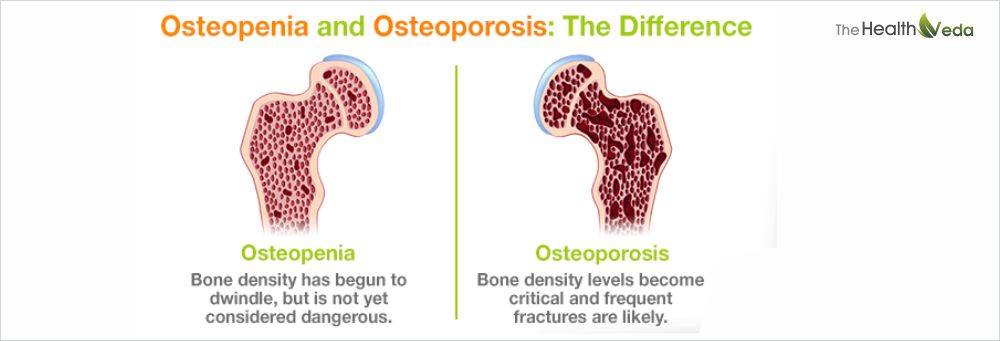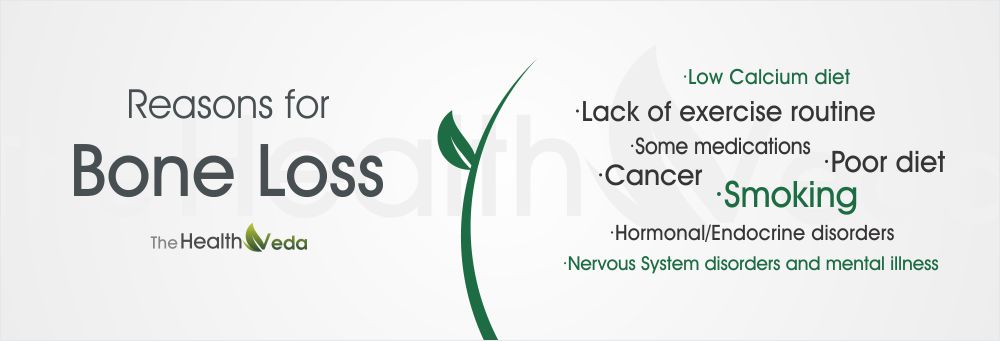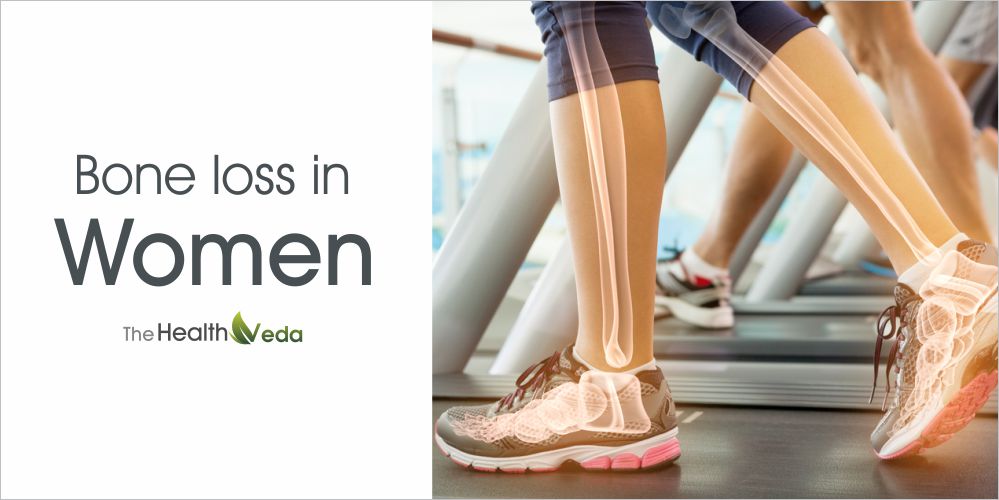Bones are hard structures made up of calcium and Vitamin D. Our skeleton is made up of bones and bones provide structural support to the skeleton and basic buildup of our bodies. A person’s lifetime is characterized by bone remodeling events. Constant Resorption (Breakdown of Old Bone) and constant Ossification (buildup of new bone) is the normal activity going in human body in controlling and reshaping/replacement of Bone Injuries like fractures. This condition happens when your body gets rid of more bone than it is creating. Imbalance in Bone Resorption and Bone Ossification events leads to net bone loss. When Bone Resorption is more than Bone Formation, Bone Loss occurs. Bone Loss can lead to:

-
Osteopenia
A bone condition marked by decreased bone density. Bone weakness and bone fragility are the consequences of decreased bone density. Osteopenia is the precursor stage of Osteoporosis.
-
Osteoporosis
It is a progressive bone loss disease. Bone loss is more in Osteoporosis than in Osteopenia. Bone break related to Osteoporosis are linked to bone breaks in spine, wrist and hip. A permanent pain in association with limited mobility is characteristic of osteoporosis. It may further affect the vertebrate, Spine leading to stooping of postures in extreme cases.
Reasons for Bone Loss
The Childhood and teenage years are very important for bone buildup. Maximum bone formation occurs through these years. By reaching the age of thirty, maximum bone density is achieved. Maximum bone density is characterized by maximum solidness and strength. Women in their first years after menopause suffer maximum bone loss. Also, Women have lower Bone Mass than men and Hormone Changes at Menopause put Women at the risk of catching up Osteopenia and Osteoporosis. Men having low testosterone level also put them at the risk of developing early episodes of bone loss. Older age put both sexes to risk of developing bone loss. As the Human Age, so are the cells and so are the mineral rich bones. General Causes of Bone Loss are as follows:

-
Low Calcium Diet
Calcium is the essential mineral needed for bone formation. A low calcium bone diet can play havoc with the bone development in a childhood and early teenage years. Milk, Yoghurt / Kefir, Cheese, Broccoli, Almonds and Okra should be incorporated in Diet.
-
Lack of Exercise Routine
Sedentary lifestyle and a good exercise routine make Bones Unhappy. The Metabolism of the whole body is improved by exercise routine in daily schedule. Half an hour walk for elderly people can do wonders in keeping the Bones Healthy.
-
Smoking
It is a bad Lifestyle Habit. Smoking lowers Estrogen Hormone levels in both Men and Women. Calcium is held by the bone with the help of Estrogen. Smoking is a risk factor for Osteoporosis and Osteopenia.
-
Some Medications
Aluminum Containing Antacids, Chemotherapeutic Cancer Drugs, Anti Seizure Medicines, Steroids like cortisone and Prednisone lead to exaggerated Bone Loss issues.
-
Hormonal/Endocrine Disorders
Hormones govern our Mood and Overall Metabolism of the Body. Diabetes, Thyroid Hormone Disorders, Irregular Periods, Premature Menopause, Low Estrogen levels can lead to Bone Loss Episodes.
-
Nervous System Disorders and Mental Illness
Mind controls the Biochemistry of metabolic reactions going inside our body.Stroke, Spinal Cord Injuries, Depression may aggravate Bone Loss.
-
Gastrointestinal Disorders
The nerve endings penetrating the gut give the direct link between brain and stomach problems. Inflammatory bowel disease and celiac disease are the two main underlying conditions leading to bone loss. Refer
-
Cancer
Sex specific Hormone changes in Male and Female can give rise to breast and prostate cancer. These cancers are the risk governing factors for exacerbated Bone Loss Problems.
-
Poor Diet
The first priority is to have enough Calcium and Vitamin D in Diet. Curbing High Salt in Diet also helps. Post Menopause Women who are more prone to Bone Loss should curb their salt intake. A source explains that for every intake of 2,300 milligrams of Sodium (salt is basically Sodium Chloride), 40 milligrams of calcium is lost in the urine.
Menopause and Osteoporosis
Some people are genetically prone to Bone Loss Disease of Osteoporosis, with a family history of the condition and being women puts you at greater risk of having High Bone Losses as compared to men. Osteoporosis affects about 200 million women all over the World as reported by International Osteoporosis Foundation. Click for More details.

A direct relationship is being found by low levels of Estrogen levels during Menopause and the development of Osteoporosis. Early Menopause before the age of 35 years and prolonged Periods/Skipped Menstrual Periods can cause loss of Bone Mass.
Further Women have lower bone mass than men. So hence risk of osteoporosis is increased in women. An adequate intake of Calcium and Vitamin D, Limit Alcohol Intake, kill the Smoking habit as it starts, exercise in routine can help prevent Osteopenia and hence Osteoporosis.
Bone Loss in Women? If you have any other information, Please add in Comments.


My mom was suffering from body aches .And we had no clue why ,discovering later it is due less vitamin D in her body.Reading this i am able to connect the link between her menopause and body ache.Nice info..Health Veda.